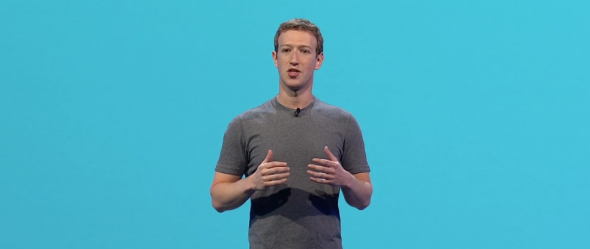
5 Things You Need to Know about Facebook’s Next 10 Years
This week at Facebook’s annual developer conference, F8, in San Francisco, CEO Mark Zuckerberg laid out the social network’s plans for the next decade. Here’s how he plans to keep the more than 1 billion people that use Facebook every day engaged—and lure in still more users.
 Facebook CEO Mark Zuckerberg laid out ambitious plan for his company’s future at an event in San Francisco this week.
Facebook CEO Mark Zuckerberg laid out ambitious plan for his company’s future at an event in San Francisco this week.
Bots are your new friends
Facebook is allowing companies to build automated “bots” on its Facebook Messenger mobile app that users can interact with to do things like get the weather or news or buy things like flowers or burgers (see “Facebook Wants You to Chat with Business Bots”). So far, companies including flower seller 1-800-Flowers.com, Burger King, and Dutch airline KLM have signed on.
Chatting with a bot via Facebook Messenger is similar to having a chat with a friend—albeit a friend who only wants to talk about one topic and serves up limited responses to your text-based missives. For instance, the 1-800-Flowers bot gives you options to order flowers or speak with customer support; if you tap “Order flowers,” it wants to know the shipping address and delivery date, and lets you scroll through a handful of options. No small talk here, as far as we could tell.
If businesses can figure out ways to make this engaging and easy, Facebook could generate a lot of revenue from such bots; for now, though, it’s hard to tell why you’d want to get information or buy things this way rather than via a smartphone app or a website.
Prepare to see a lot more live video
Sharing and watching videos are already popular activities on Facebook, and the social network sees this evolving to include much more live video. At F8, Zuckerberg noted that so far people tend to watch live videos longer than they do regular videos, and comment on them 10 times as much.
In hopes of making live video even more prominent on the social network, the company released software tools that let developers stream live video to Facebook from any device, such as drones.
Facebook’s algorithms know what’s in your photos and videos
Facebook is building out software capable of recognizing just about anything inside photos and videos uploaded to the service. At F8, Joaquin Quiñonero Candela, Facebook’s director of applied machine learning, demonstrated a system that lets you search photos that you or friends have put on Facebook using text. For example you could type “mountains” to dig up snaps of a hiking trip from last summer.
Candela didn’t indicate when that service might launch, but it’s plausible it could come soon; the demo was powered by the same deep-learning technology behind the Google Photos service that debuted last year (see “How Computers Can Tell What They’re Looking At”).
Facebook has developed software capable of recognizing the different components of images.
And this same technology is being used to make a system to automatically categorize the aforementioned live videos that Facebook hopes will flood into the social network’s service. In the future, you might be able to find something to watch by searching for your favorite sports team, for example, and surface the most relevant live streams and past clips. Facebook could also automatically recommend videos it thinks you will like.
VR will let you socialize in virtual space
Facebook has two virtual reality headsets on the market: the Oculus Rift and the Gear VR (developed with Samsung). But headset technology is still in its early stages, and there is only a limited selection of games and movies to experience. Zuckerberg wants virtual reality to be something everyone uses to socialize, because that seems like a key way to get people to stick with VR over time.
On Wednesday, Facebook’s chief technology officer, Mike Schroepfer, demonstrated an early idea of how that might look. He fooled around with a colleague in a virtual space where people appear as disembodied heads and hands, and used a virtual selfie stick to snap photos of the two of them. It looked a lot more fun than it sounds.
Facebook’s Oculus group is working on other ways of making virtual socializing more realistic, too. Researcher Yaser Sheikh, a recent hire from Carnegie Mellon University, talked about using a dome studded with over 500 cameras called the Panoptic Studio to study people’s body language in 3-D as they interact. He said Facebook wants to make getting together in virtual space, to catch up with a friend in another city or for a job interview, close to real life. “It would be by far the most compelling electronic social experience yet,” said Sheikh. “The distance between you and the people you care about would melt away.”
Facebook plans to rewire the Internet
In recent years Facebook has rolled out a series of projects aimed at getting more people online. It provides subsidized Internet access to certain services in dozens of countries around the world, and is working on a solar-powered drone called Aquila (which means “eagle” in Latin) with the wingspan of an airliner to beam Internet to rural areas where cellular infrastructure is too pricey to build (see “Meet Facebook’s Stratospheric Internet Drone”).
This week, Facebook also unveiled two new projects aimed at upgrading the Internet. One is a system that uses high-speed wireless technology to wire urban areas with Internet access, as an alternative to laying new fiber-optic cables (see “Facebook Is Testing a Super-Speed Public Wi-Fi System”). Another is a way to pack more data into wireless connections used to link cell towers back to their operators and the Internet. Facebook intends to give away the designs for this new technology for free, in the hope that telecommunications companies will adopt it. That serves the company’s professed desire to get more people online for humanitarian reasons. It also serves the company’s profit motive by creating more potential targets for ads (see “Facebook’s Two Faces”).

 This dome at Carnegie Mellon University is used to study the role of body language in communication.
This dome at Carnegie Mellon University is used to study the role of body language in communication. Microphones and more than 500 cameras line the inside of the dome, which can capture people’s movements in 3-D.
Microphones and more than 500 cameras line the inside of the dome, which can capture people’s movements in 3-D.
Leave a Reply